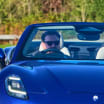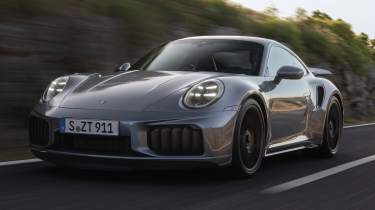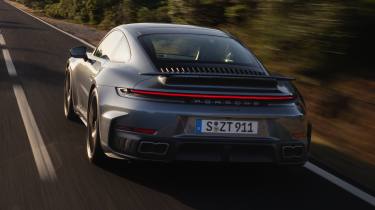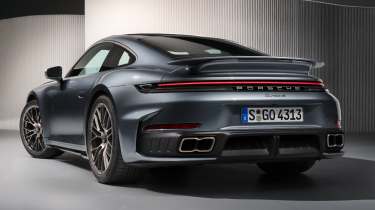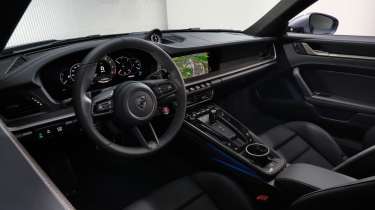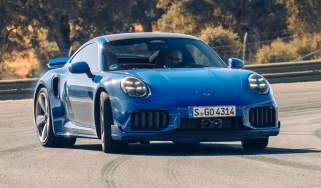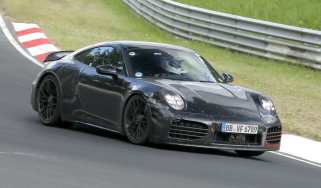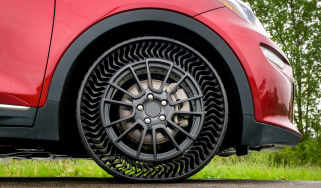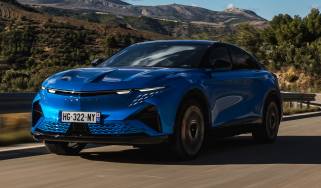2026 Porsche 911 Turbo S revealed – new all-weather supercar gets electrified 701bhp
Porsche has leveraged its T-Hybrid tech to create the most powerful series production 911 yet made
Nothing less than the most complete, capable, and accessibly performant 911 yet to exist. That’s what we expect of every new Porsche 911 Turbo, right? The new 701bhp 992.2 Turbo S shouldn’t be an exception, especially at the £199,100 the new coupe will start at – quite the jump up from the £168,900 the 992.1 cost when introduced in 2020.
For that you do get the most powerful series-production 911 to date, along with a load of other changes under the skin besides, to an end of being some 14 seconds quicker around the Nürburgring than its predecessor. It should be every bit the do-it-all pseudo supercar rival to everything from McLaren’s Artura to Aston Martin’s Vantage S, Mercedes-AMG’s GT63 and the new Ferrari Amalfi. Here’s how.
992.2 Turbo S – a 701bhp hybrid, sort of
The oily bits first. Gone is the old 641bhp 3.7-litre twin-turbo flat-six of the old 991.2. It wasn’t exactly wanting for power or performance but it was a bit low-tech, at least by comparison to this new car. Here we have a 701bhp, 590lb ft twin-turbo 3.6-litre flat-six, now mounted 50mm lower than in the old car. It’s similar in block design to the motor found in the GTS, with no belts and no conventional alternator or starter motor thanks to the T-Hybrid system.
> The new 992.2 Porsche 911 GT3 RS isn’t far away – here’s our best look yet
Indeed the Turbo S features the same 1.9kWh high-voltage battery and 400-volt electrical system first seen in the GTS, as well as the eight-speed PDK transmission with an integrated electric motor. In addition to performing starter and alternator duties, the motor contributes up to 81bhp to total system output at high engine speeds.
As in the GTS, Porsche deems the battery size insufficient to allow electric-only driving and elected against increasing its size, deeming the weight gain simply not worth it. Was a full plug-in system considered? Yes, but once again, weight is the enemy and such a system could well have resulted in this being the first two-ton 911. The response to that from Porsche’s director of the 911 model line, Michael Rösler, was, ‘Is it a 911, or a truck?’. Incidentally, all the new tech has added 85kg of weight, meaning the 992.2 Turbo S is now over 1700kg at the kerb.
Where the Turbo S’s engine really differs to the GTS’s is in how it’s turbocharged. Instead of the single large eTurbo found on the GTS, here there are two smaller electrified turbochargers on boost duty. Turbine- and compressor-wheel sizes in the GTS’s turbo are 83mm and 80mm respectively, compared to 73mm and 65mm for the two in the Turbo S.
They’re bigger than those found on the 992.1 Turbo S, however – by 10mm for both the compressor and turbine wheels, with lag not a concern thanks to the integrated electric motors that augment boost build-up, while also being able to return up to 28kW to the electrical system when off throttle. There’s no mention of how this affects performance, but the engine also features asymmetrical timing, in order to give the new Turbo S more distinctive vocals – not ever a strong suit for the model. The new sports exhaust system with a titanium rear section should help where that’s concerned too.
How does this all manifest? The headline numbers are 701bhp from 6500 to 7000rpm and 590lb ft from 2300 to 7000rpm. That torque figure might be unchanged, but the curve is now more of a line after 2300rpm, rather than a peak that starts to drop off after 4000rpm as in the 992.1, which wasn’t exactly a slow or unresponsive car.
So, T-Hybrid motor in and job done? Not quite. In terms of chassis and handling there’s everything from small detail changes to new technologies that take advantage of the new 400-volt electrical system. Starting with the latter, the new electrohydraulic Porsche Dynamic Chassis Control system, or ehPDCC – the acronyms just get catchier, don’t they? It’s standard on the Turbo S, and put simply means its four corners aren’t independent, but it’s also not the full Taycan/Panamera Hybrid-spec ‘Active Ride’ that can make those cars dance.
Here, active coupling rods are hydraulically cross-connected with oil flowing between them based on the driving conditions. More loading means more support. As above, it can’t push the car up or lower it down, it can’t lean into the corner – more the better, as those systems feel like the dynamic equivalent of the uncanny valley. What you can option is a nose lift that runs off the system and is therefore very fast-acting when you press the button. Porsche claims the net result is improvements all round in both ride quality at normal speeds and platform control when you’re pressing on.
Other detail changes? The 325-section Pirelli P Zero R tyres at the rear are 10mm wider than on the 992.1 Turbo S, with the fronts carrying over. There are also 420mm (20mm bigger) PCCB brake discs at the front, with the rears staying the same, though the pads are a new compound. The PTM four-wheel-drive system is much the same, with detail calibration changes to account for where the mass is in the car and the nature of the power delivery.
Porsche 992.2 911 Turbo S – 0-62mph, top speed and Nürburgring time
Unsurprisingly the new Turbo S is quicker than the old one, even with the extra podge, getting to 62mph in 2.5sec (0.2sec quicker) and to 124mph in 8.4sec (0.5sec quicker). Just how much quicker it is in the real world is probably best illustrated by the fact that the new car would be two car lengths ahead of the old car after 2.5 seconds of full-bore acceleration from a standing start. Again, the last car was no slouch… Top speed is a nice, round, even 200mph for the coupe.
Everything adds up, but it’s the barrel-chested powertrain and tautened responses from the new suspension that Jörg Bermeister told me was the key to setting the 7-minute 3.92-second Nürburgring time. I believe him, given the G-forces from the flat-out ride in a prototype around Weissach aged my face by about ten years.
Design-wise there’s a lot that’s familiar. You could reductively call it a love child of the old Turbo S and new GTS, with the latter’s active vertical slats now integrated into the Turbo S’s face, along with revised lighting front and rear, tweaked bumper lines and the ‘Turbonite’ badging and brightwork. It is an aerodynamically more effective car though – a new active diffuser under the nose now works with the unchanged active splitter and wing to better control airflow, while wet braking is improved by the active elements closing to shield the braking system from water in wet conditions. Altogether the new Turbo S has ten per cent less drag than the old car when the aero is in its most efficient position.
Inside too the 992.2 is largely Turbo S as you remember it, with some losses – we’re now used to the absence of the lovely physical rev counter in 992s of old. We’re also used to the disappointingly generic start button and ever-shrinking drive selector. Sadly, unlike in the GT3, we don’t have a dedicated button to expedite the process of shutting up all the ADAS nannies, or a special tacho setting that puts the red line to the top of the dial. Happily, the new folding carbon bucket seats will be an option.
The new 992.2 Porsche 911 Turbo S will be priced from £199,100 for the coupe and £209,100 for the cabriolet. That’s a punchy jump of £32k in the five years since its predecessor’s introduction. But then this is a pseudo supercar – a four-seater, daily-drivable (if less exotic) alternative, by the numbers at least, to all sorts of rivals from GT cars to supercars, that’s likely every bit as quick if not quicker in the real world. Order books open now and first deliveries are expected by the end of the year.
2026 Porsche 911 Turbo S specs
| Engine | 3.6-litre twin-eturbo flat-six |
|---|---|
| Transmission | Eight-speed PDK PTM AWD |
| Power | 701bhp @ 6500-7000rpm |
| Torque | 590lb ft @ 2300-7000rpm |
| Weight | c/1725kg (413bhp/ton) |
| 0-62mph | 2.5sec |
| Top speed | 200mph |
| Price | £199,100 (coupe), £209,100 (cabriolet) |
| On sale | 2026 |
